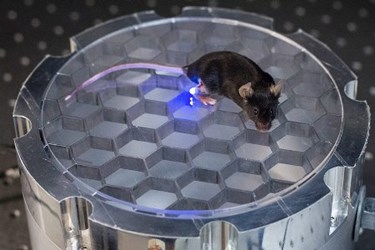Stanford Scientists Develop First Optogenetic Nerve Stimulation Wireless Implant

A fully implantable device developed by scientists at Stanford Bio-X provides optogenetic nerve stimulation that is powered by movement. By removing cumbersome external equipment, researchers have enabled mice implanted with the device to move more freely, granting the researchers a better opportunity to observe processes that could advance neuroscientific research.
Optogenetic methods use light to control and monitor neurons that have been genetically preconditioned to respond to light. Many experts believe that it is the best technology yet created for delving into the secrets of brain function, the mechanics of brain failures and their resulting psychiatric disorders.
Studies of mice using optogenetics have uncovered secrets about Parkinson’s tremors, the mechanics of pain, and possible stroke treatments. Traditionally, scientists have mounted external headgear onto the mice and delivered pulses of light externally.
Ada Poon, an assistant professor at Stanford, wanted to develop a way to deliver stimulation that was more sophisticated and less obtrusive to a mouse’s natural behavior. Cumbersome headgear gets in the way of tunnel navigation, burrowing, and other behaviors that might be part of a potential experiment.
In a Stanford News article, Poon explained that experiments studying depression and anxiety, two of the world’s most misunderstood mental disorders, often require components such as mazes and complex movements that are virtually impossible if the mouse is wearing a helmet.
The main challenge of the device was finding a way to power it efficiently without external wires or damaging electrical components. Together with John Ho, an assistant professor at the National University of Singapore, Poon published an article in Physical Review Applied outlining a way to use a mouse’s bodily movements to transfer radio frequency energy.
In the latest study published by Poon’s team in Nature Methods, researchers describe how they incorporated the energy harvesting methods into a fully implantable device the size of a peppercorn, two orders of magnitude smaller than previously reported optogenetic systems. Through it, they were able to manipulate the mouse’s brain, spinal cord, and peripheral nerve endings.
“This technology opens the door for optogenetic experiments in which animals are able to behave naturally with optogenetic manipulation of both central and peripheral targets,” wrote the study authors.
Poon reported to Stanford News that, compared to previously introduced systems, her team’s device was much smaller, a fact made possible by the novel power source. “This is a new way of delivering wireless power for optogenetics,” she said.
It is the researchers’ hope that their technology will one day help in the treatment of mental disorders.
The World Health Organization (WHO) estimates that 400 million people worldwide suffer from chronic mental illness, and said it’s the single largest contributor to global disability. The WHO will host a meeting with The World Bank next year, launching an initiative called “Out of the Shadows” to make mental health a global priority.
Last September, The National Institutes of Health (NIH) awarded an initial $46 million to research groups exploring innovative technologies that could help scientists better understand brain function.
NIH Director Francis Collins said, in a press release, “The human brain is the most complicated biological structure in the known universe. We’ve only just scratched the surface in understanding how it works—or, unfortunately, doesn’t quite work when disorders and disease occur.”
